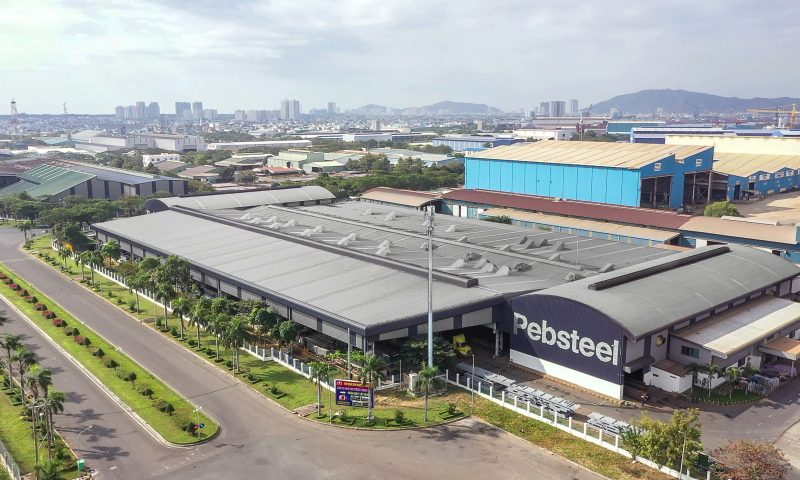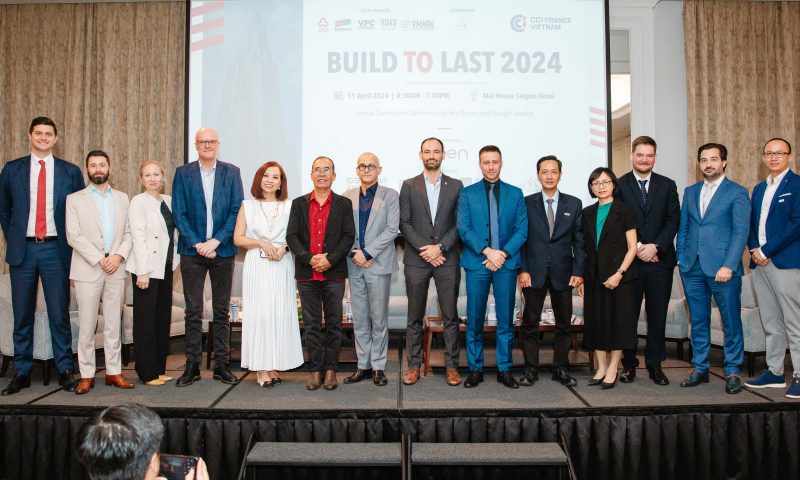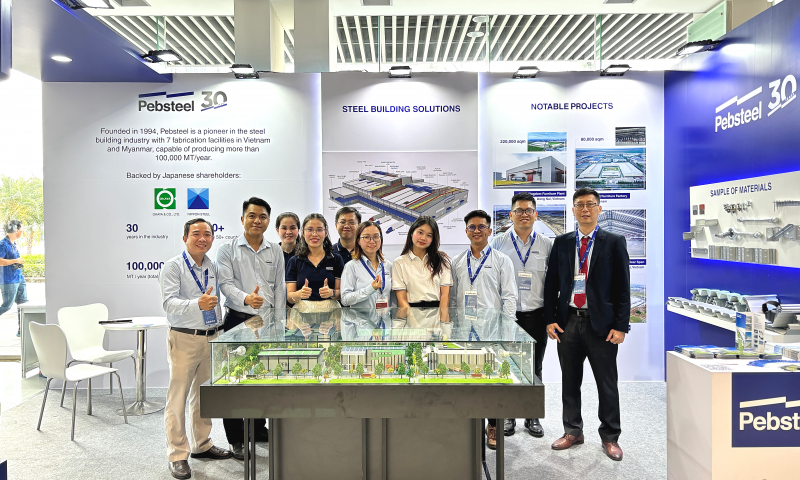Steel structure erection is the final step in the entire Design – Manufacture – Erection process. This step is also the step that determines whether the project is guaranteed to achieve the highest efficiency or not. In the following article, let’s learn about the principles and detailed construction process with Pebsteel.
Read more: Standard building process for factory
1. General rules for steel structure erection
- Carry out the erection of columns in combination with girts(if any), then install a bracing system to brace the columns together. The columns must be aligned correctly before the erection of the truss can begin.
- Depending on the method of construction and erection of the structure, the rafter frame will be erected from the inside and installed outside the rafter frame (in the direction of the crane truck).
- The erection must start in the compartment with column and roof bracing (wind bracing).
- It is necessary to fix the erection frame according to the wind-bracing position before erecting the adjacent frame. This process will be repeated for subsequent frames.
- Temporary bracing during the erection of steel structures is required. Wall girts and roof purlins are linked with bracing cables to position and connect the trusses together.
- Before starting to install corrugated iron, it is necessary to align the rafter frame, align the purlins and, clean, then repaint the scratches.
- It is necessary to stretch the rope or use chalk to mark and determine the locations of landmarks to align the steel sheetings at the stage of completing the cover.
- When workers walk on the roof, be careful to only step on the concave wave (also known as the lower wave), and avoid stepping directly on the convex wave (also known as the high wave) to limit crushing, denting, or corrugated iron.
- Do not move in places with light roofing.
Read more: What is Structural Steel? Types of Structural Steel and Shapes
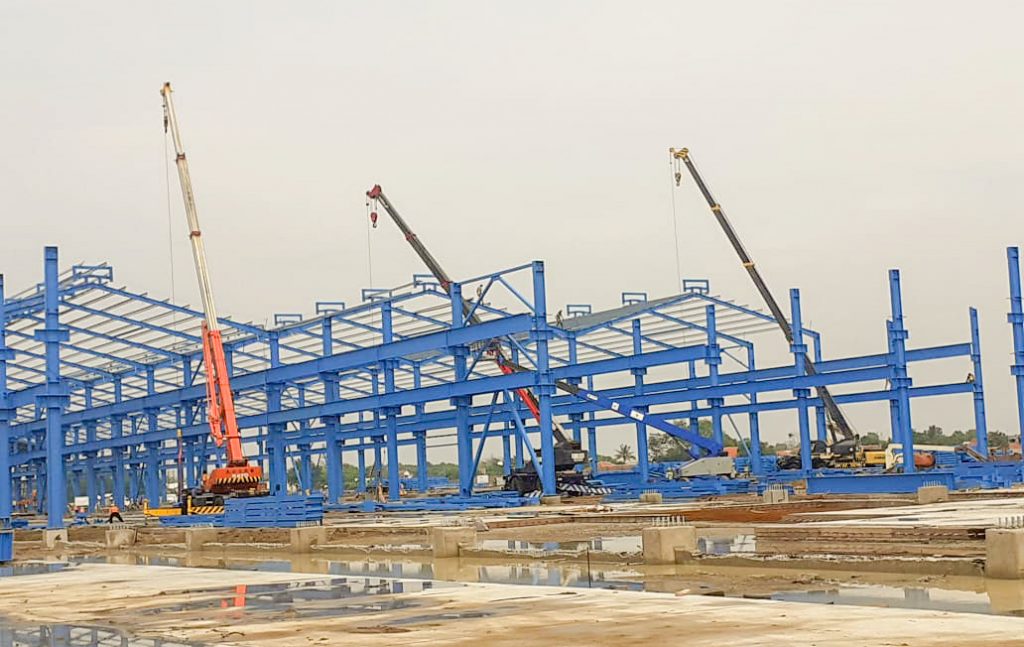
2. Steel structure erection steps
- Step 1: Prepare before erection
Construction materials and equipment are two key factors that determine the quality of the project. As long as there is a problem with one of these two factors, such as low quality, insufficient quantity, lack of safety ensuring, lack of consistency with the requirements of the structural drawings, etc., the construction will be delayed, leading to a decrease in the quality of the work. Therefore, in this step, the construction contractor must pay attention and check the quantity and requirements of materials and equipment.
Read more: What is a corrugated steel roof rafter? Categories for Quality rafter
- Step 2: Erect the column & rafter
Columns are factors that affect the bearing capacity of steel structures. The rafter has the function of supporting the roof, linking it with the rest, helping to fix the roof firmly, and at the same time increasing the factory’s aesthetics. Installation must be carried out following the technical requirements for erection and production.
- Step 3: Erect purlin & brace
Based on the designed location and quantity, the complete installation of purlins and truss rods is carried out. Then, the workers will proceed to align the position of the rafter beams.
Read more: Design Standards & Aesthetic Steel Frame Factory Design
- Step 4: Calibrate the first frame
This is the stage where components are placed in precise positions and calibrated to ensure the safety, accuracy, and stability of the entire construction project.
- Step 5: Erect the next frames & complete installation for the rest of the frames
After completing the alignment and installation of the first pavilion frame, the next step is to install the remaining pavilion frames to complete the main structure of the project.
- Step 6: Erect louver
This step ensures that the project will not be affected by environmental and weather impacts. Performing this step requires care, precision, and the use of appropriate materials to ensure the stability and safety of the steel structure.
- Step 7: Check completion before covering
This step ensures the steel structure is made correctly and ready for the final covering and finishing stages. Errors in steel structure erection can affect construction quality.
- Step 8: Erect covering and finish
This is the final stage in the steel structure erection of a building. In this step, covers such as louvers, exterior panels, insulation systems, finishing materials, and other components will be installed to protect and create the final beauty of the building or structure.
Read more: What is the Crane? Classification and Application in Constructions
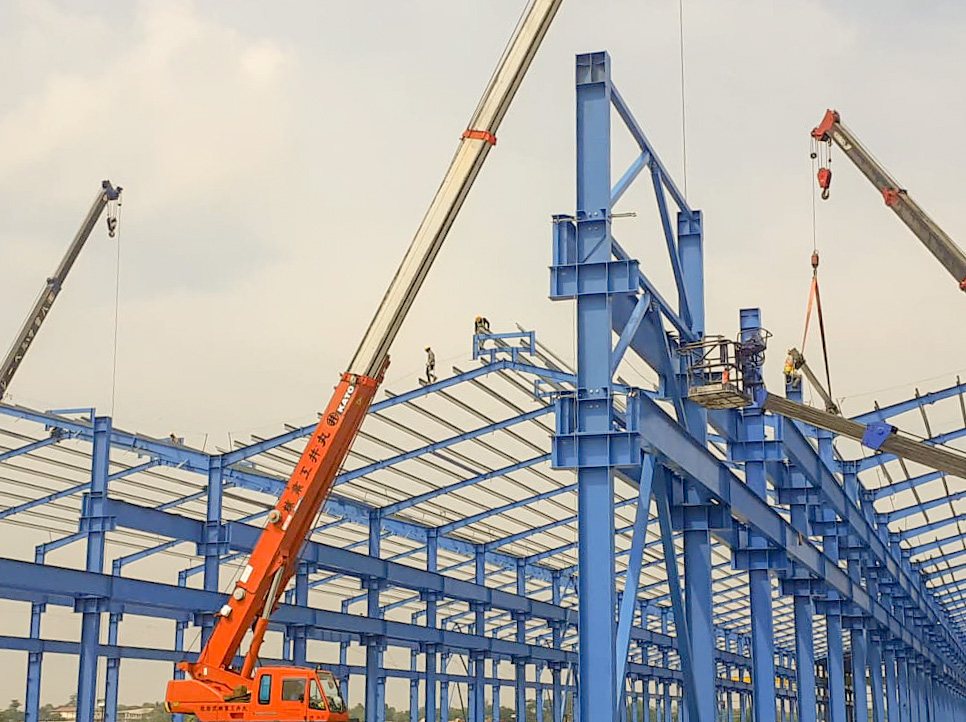
3. Necessary Construction equipment
3.1. Mobile machinery equipment
- Mobile machinery equipment includes truck cranes, delivery trucks, hoists,…
- Only inspected mobile equipment and skilled operators are allowed on the construction site.
- All electrical conductors must be fenced or flagged at locations where mobile machinery may be exposed to electricity. In addition, it is necessary to disconnect electrical wires that can cause accidents or take safety measures before carrying out any construction activities.
- All types of equipment are not allowed to operate directly above the electricity cords.
- Do not operate machinery with a distance of less than 4.5m from a power source with over 220 volts.
- Avoid moving near or directly under an object being lifted. Every heavy thing being hoisted must have a steering rope (also called a tagline) to steer the object.
- Must determine the position of the crane and the position of lowering the crane on the construction site before lifting any object. It is mandatory to carry out safety measures to ensure labor safety and analyze possible hazards (according to the Work Safety Procedures in Site Installation).
- At all stages of construction, it is necessary to limit damage to the painted finish of the structure. It can be overcome by using nylon belts or crane lanyards combined with protective cushions in places in direct contact with the steel structures. Alternatively, you can use bolt-type anchor shackles for lifting.
Read more: Bolt Connections In Steel Structure
3.2. Crane ropes and slings
- A thorough inspection of the slings and hoisting ropes is mandatory. Any damaged cables or slings should be cut off and destroyed immediately.
- During the hoisting process, limit the arbitrary use of hoisting ropes. Be sure to protect the crane rope by padding areas with sharp corners. Do not allow sudden jerks when hoisting; sudden jerks will increase the load by 3 times compared to normal, which is extremely dangerous for the crane rope. When not in use, the crane rope should be neatly tied up. Do not let the crane rope become overloaded.
3.3. Construction scaffolding
- There needs to be a plan to use and install construction scaffolding appropriately. Affecting the crane’s movement, obstructing the boom arm’s reach, and causing difficulty in erection operations should all be avoided.
- Always place scaffolding on hard ground; or alternatively, it must be lined with boards with a minimum size of 200 x 200 mm. Separate scaffoldings are required to be fastened to the fixed structure, with a space of at least 1.5m. Each upper level of scaffolding needs to be tightly tied to the lower level with steel wire or scaffolding pipes to ensure safety.
3.4. Hand tools
- All hand tools must have a protective lanyard to prevent them from falling during construction.
- Equipment must be used for its intended purpose. Do not use handheld devices to do tasks other than their intended purpose. Avoid using temporary replacement devices.
- Do not use damaged tools, machinery or equipment with torned and frayed windings, technical errors or no protective caps.
4. Conclusion
Above is information about the steel structure erection process and some related information. During the erection process, construction units must strictly comply with standards and labor safety procedures to bring about solid, modern steel structures. If you require advice on pre-engineered steel buildings & steel structure construction services, please contact Pebsteel via email at Marketing@pebsteel.com.vn or phone at +84 908 883531.





